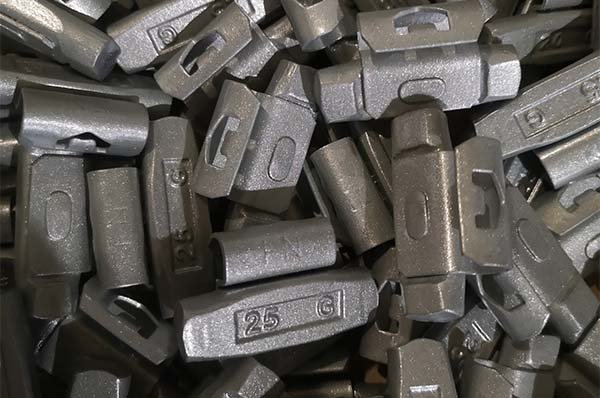Wheel weights
When balancing a customer's tire, wheel weights are used to correct any imbalances. Placing the correct wheel weight in the correct location helps ensure proper performance of the tire. By applying weight to the wheel in a specific, precise location, the additional balancing weight distributes the wheel's mass more evenly about the axis of rotation. This ensures that the wheel does not vibrate as it spins. Using modern wheel balancing equipment, it is easy to place the weight location and desired amount of balance.
There are two main types of wheel weights used: clip-on wheel weights; and stick-on wheel weights. The "correct" wheel weight depends on the technician's preference and the wheel application.
Essentially, technicians often prefer more malleable materials for clip-on weights so they are easier to install, faster, and with less force. There are a wide variety of clip-on designs, allowing technicians to match them to the contour of the rim flange.
With adhesive weights, the material is not as important as the quality of the tape that holds it to the rim.
Clip-on wheel weights are the industry standard and the fastest to use during the balancing process. The design concept has not changed much since they first became popular in the 1930s. Knocking them into the correct position on the wheel rim flange is a quick process compared to the steps required to stick adhesive weights.
It is important that the contour of the clip-on weight used matches the contour of the rim flange. If the weight design is not properly matched to the rim, it can cause the weight to move on the rim, fall off the wheel, or scratch the rim.
If the wheel does not have a flange, adhesive wheel weights (also called "stick-on" or "tape-on" weights) are the best choice. Adhesive wheel weights are a good option for customers who want a certain aesthetic to their wheels, as the weights can be placed behind the spokes or integrated into elements of the wheel design.
With adhesive weights, proper surface preparation takes more time but helps ensure quality balance. Make sure the surface on the inside of the rim is clean. This includes properly removing any existing weights and any remaining adhesive residue.
It is also important to clean the wheel before applying new wheel weights. Once the wheel surface is clean and the proper weight has been determined, remove the backing of the wheel weight strip and center the weight over the imbalance point. Apply pressure to ensure firm contact with the rim.
Finally, re-spin the assembly to ensure proper balance.


